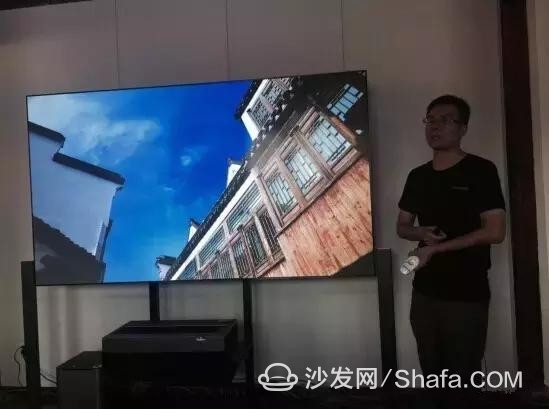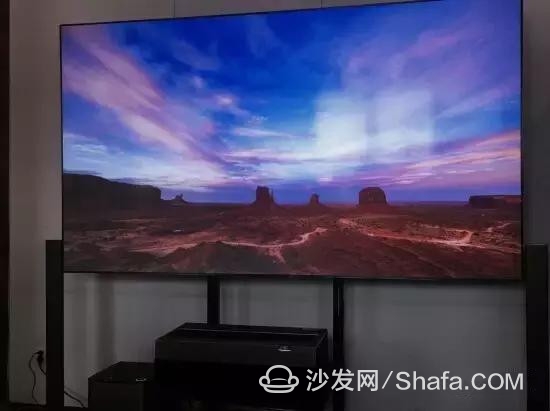For professional photographers, a good work not only requires meticulous design, accurate capture, and shooting techniques, but it also requires the use of post-processing to sculpt and eliminate defects. Many newly-camera enthusiasts may think that as long as they master superb photography technology and have a professional photography equipment, they can shoot wonderful photos. Actually, senior photographers all know that another important output link that cannot be ignored in photography is to provide a professional-level display device to help the most beautiful aspects of their work. 




Recently, the director of the Photography Society of Tsinghua University and National Geographic photographer Chen Haijun expressed at Hisense 4K laser television tasting session that for professional photographers, "color is life," so the requirements for display devices are very high. In particular, the core indicators such as resolution, color reproduction, contrast, and viewing angle are more demanding. If a display device cannot restore the true colors and details of a photograph, it is “bloody at heart†for photographers. Therefore, it is very important to select the colors displayed by the display device in the later viewing photos, and to have super high resolution, accurate color reproduction, and powerful color rendering capabilities, which can perfectly present static photographs and dynamic video images. . Bringing better visual experience and creative inspiration to professionals, making it more handy in the post-processing of the work.
Chen Haishun frankly stated that before he did not come into contact with Hisense 4K laser TVs, he generally chose a professional-grade high-end display to view photos, and then proceeded to post-processing. However, after coming into contact with Hisense 4K laser television, this changed my understanding of the color performance of large-screen TV display devices.
In order to prove Hisense 4K laser TV's 4K ultra-high resolution, color reproduction, contrast, and depth of field and other details of sharpness, Chen Haijun carefully selected 30 high-quality works of different styles on Hisense 4K laser TV Come to show. Hisense 4K laser televisions have shown outstanding results for different styles of video works such as single-tone, contrast tones, multi-tones, and dark scenes. Can clearly show the quality of the color gradient, contrast between light and shade, the depth of the color depth and permeability, in the 4K large format display effect, such as the sky of the aircraft, the mountain 100 kilometers away, and a variety of color scenery photos Details wonderful reproduction reproduction.

According to Zhong Qiang, director of the R&D Institute of Hisense Laser Television, the reason why National Geographic photographer Chen Haisong's works can be perfectly reproduced and reproduced is mainly because Hisense 4K laser television adopts DLP laser source and achieves 4K picture quality, which can realize 8.3 million beams. The fine control, just as ordinary people consider screen indicators, photographers also need to consider the resolution of the screen. It's just that they are concerned about whether or not they want to see the details of the photo 100%, so it's certainly more convenient to have a larger, ultra-high resolution screen.
In addition, Hisense 4K laser television is very ideal in terms of color performance, its NTSC color gamut can theoretically reach 110% or more, and adopts full HDR technology, bringing better brightness, richer colors, and more layers. Bright.

Zhong Qiang believes that compared with 4K large-screen LCD TVs, Hisense 4K laser TV's light utilization efficiency is higher, power consumption is about 1/3 of similar size LCD TVs, and the response speed is 370 times faster than LCD TVs, nearly 70,000. The price is about 1/10 of that of a similarly-sized LCD TV, and the price/performance advantage is outstanding. At the same time, the light of the laser television reaches the human eye through reflection, and the light is very soft, which reduces the harm to the human eye. Equally important, the power consumption of the Hisense 100-inch laser TV is only equivalent to the 40-inch LCD TV, and the service life can be Tens of thousands of hours.
At the same time, laser televisions are derived from projection technology, and the distinction between laser televisions and projections, as well as doubts about the fact that projectors have never really entered the home for decades, have cropped up. These questions overlook the creativity of technological progress. Laser TVs have the traditional descent and all the advantages of projection, but they also have new technologies such as Fresnel bionic screens, laser light sources, ultra-short focal reflection paths, etc. These innovations make laser television another product of necessity. "Like LCD TVs originated in LCD monitors, the core blood lineage is exactly the same, but it is a product of two completely different experiences. Laser TV will create another history."

According to data from July, Hisense laser TV has occupied a market share of 49.64% of the large-screen market with an 85-inch or larger screen, which is a pressure on global television leader Samsung to be in the high-end large-size TV position. With such outstanding market performance, Hisense has increased its efforts in R&D and promotion of laser television. According to Hisense, it will launch a new generation of two-color laser TVs around the end of this year. The color, contrast, brightness and other advantages will be more prominent, highlighting Hisense's laser technology. The style of the pilot on television.
Smart TV/box information can focus on smart TV information network sofa butler (http://), China's influential TV box and smart TV website, providing information, communication, TV boxes, smart TVs, smart TV software, etc. Answering questions.